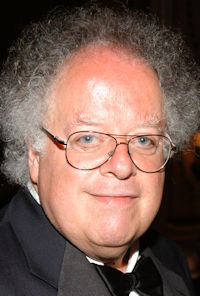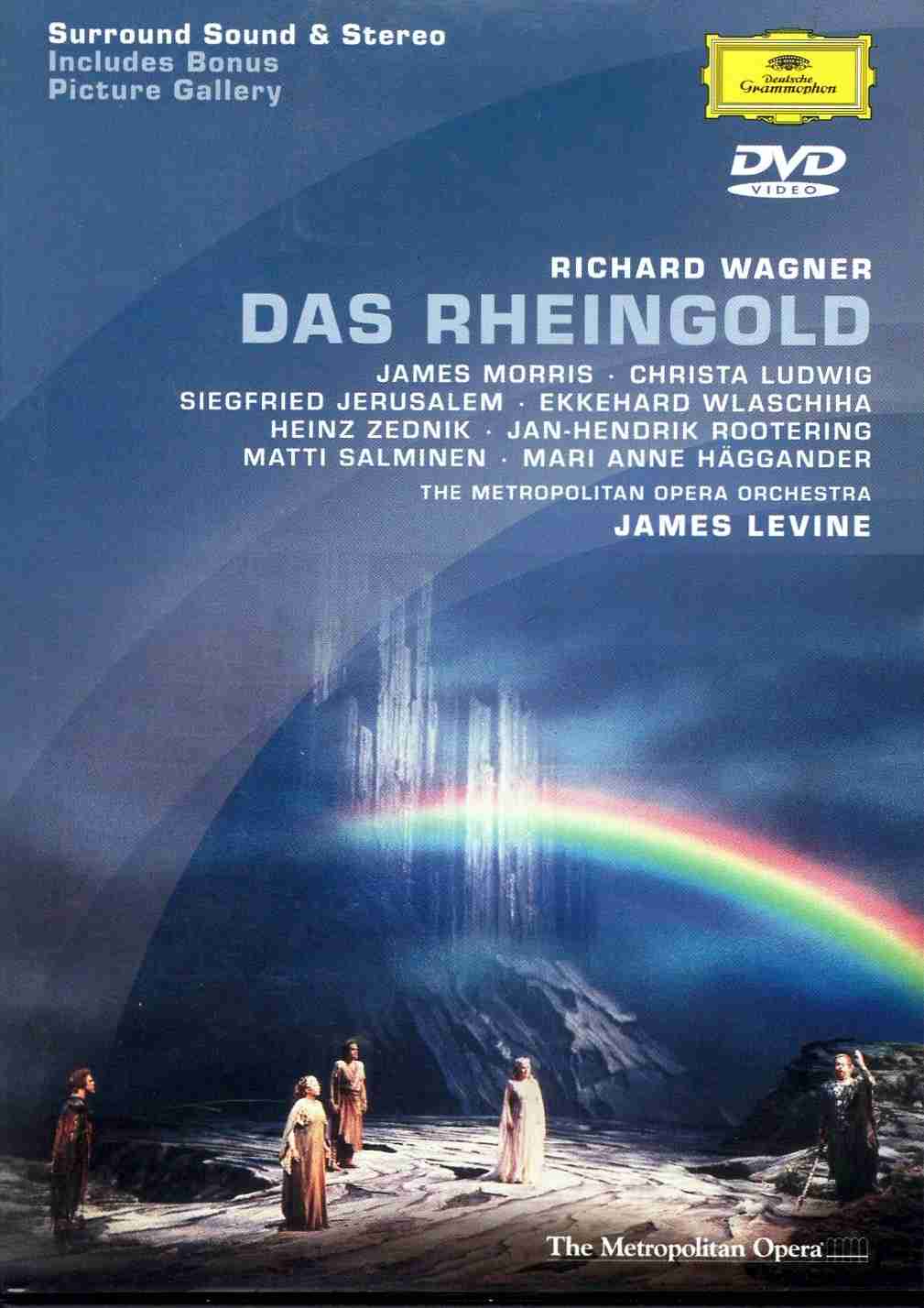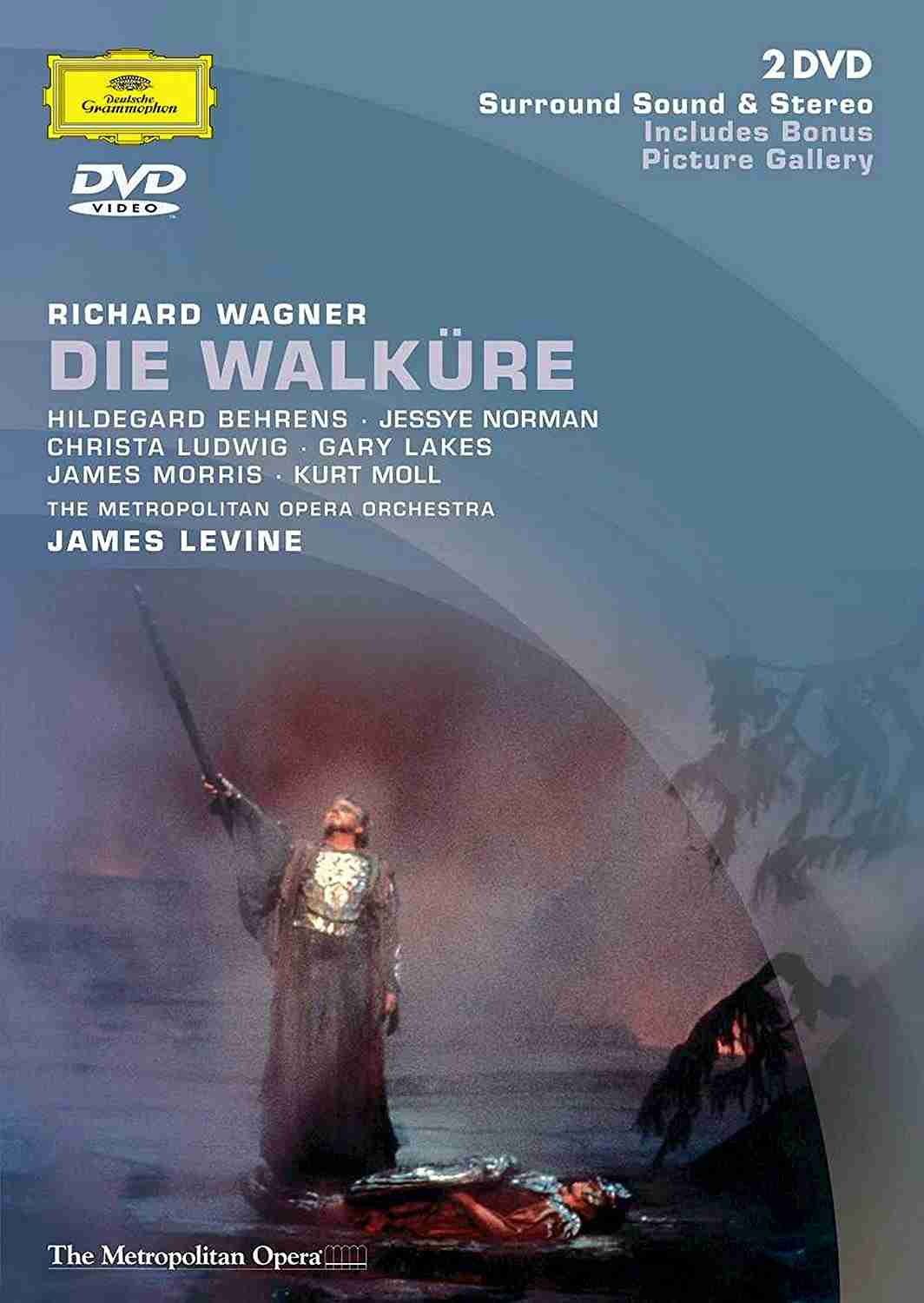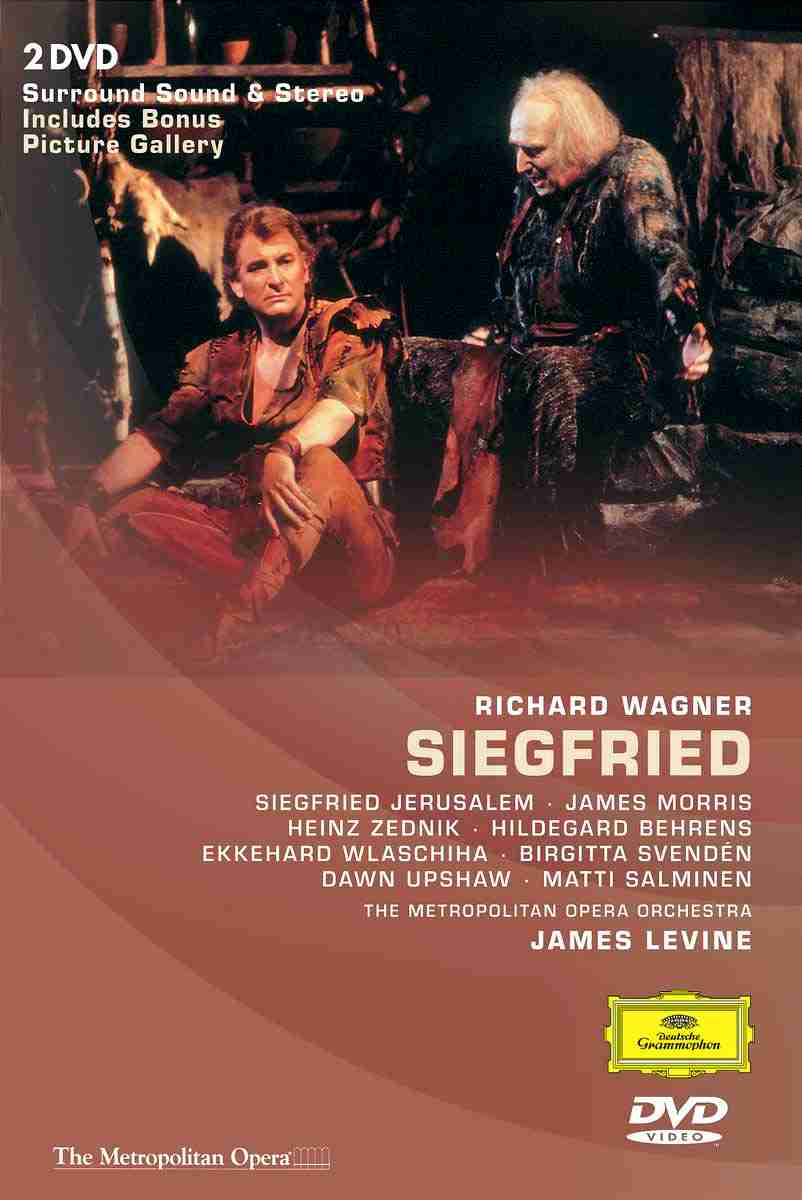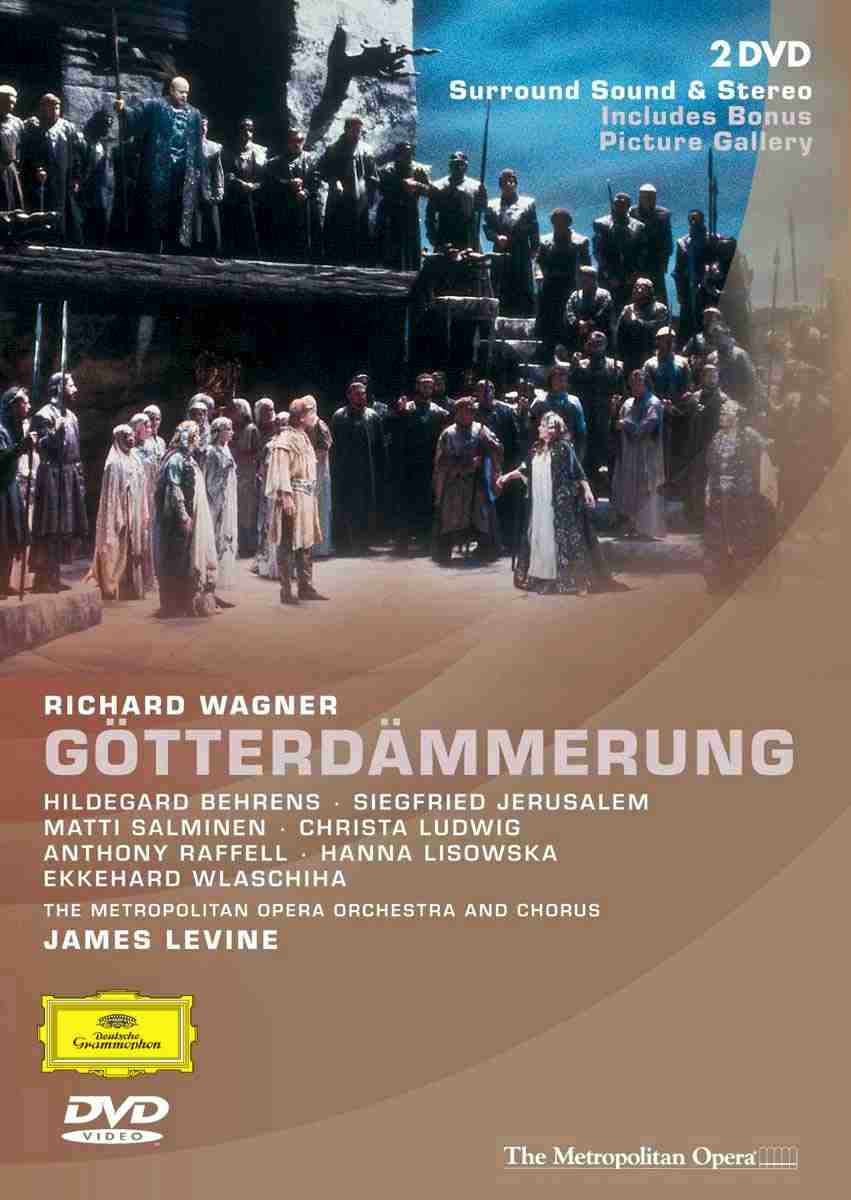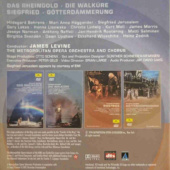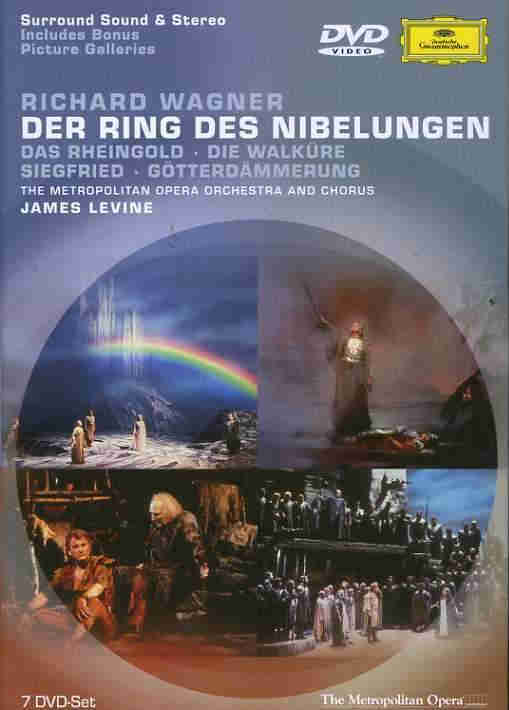Der Ring des Nibelungen
Admirers of this production praise director Otto Schenk for staying faithful to Richard Wagner´s intentions, not applying a “concept” of his own, and furthermore providing traditional sets using state of the art stage techniques to execute these visions.
Detractors, on the contrary, find the sets drearily realistic, the production short of drama and describe it as a “Nibelungen Ring Museum”. In this context it should be noted that this Met production filmed in 1989-90 is the only “conventionally staged” DVD of the Nibelungen Ring on the market.
In my opinion, the problem with this production is not Otto Schenk´s direction. The problem is that he does not direct. Rather, this is set designer Günther Schneider-Siemsen´s Ring. He is responsible for the, at times, admittedly drearily realistic sets, where most scenes take place on semi-dark rocky plateaus if not in fully dark huts and caves. Schneider-Siemssen also designed the sets for the previous Met Ring (1968-74) based on Karajan´s Salzburg Ring and this was Schneider-Siemssen´s sixth Ring production.
I do not take issue against the “conventional” staging as such– after all, there is room for plenty of interpretations of The Ring, and why not a naturalistic one as there is plenty of inherent drama in the work. And the relations and interactions of the characters may well be explored within a realistic setting.
The problem is simply that Otto Schenk does none of that. The characters seem to have been dumped unceremoniously into Schneider-Siemssen´s sets and left to their own devices. Ultimately what follows is a production devoid of true drama and my main reservation on this set is that, despite fine moments, unfortunately neither drama nor music genuinely lifts off.
Walküre, incorporating the majority of intrinsic drama, clearly is the least successful of the four operas. Most successful are Siegfried and Götterdämmerung.
Most of the major parts were undeniably cast with the top singers of the day, such as Matti Salminen (Hagen), James Morris (Wotan), Siegfried Jerusalem (Siegfried) and Hildegard Behrens (Brünnhilde).
One has to recognise that The Met has to opt for the big voices to a larger extent that venues such as Bayreuth, simply due to the size of the house. Even then I have reservations regarding the casting of several of the intermediate parts, explainable in most cases (artists with long-standing relations with the house and audiences etc., such as Fricka and Sieglinde) though not in all (Siegmund, Gutrune).
James Levine´s orchestra runs seamlessly and smooth. The shear sound is beautiful, though in a very polished way where nothing unpredicable happens. Depending on tastes, this may be an up- or downside.
This is the only traditional Nibelungen Ring available on DVD, and those attributing major importance to this fact may want to purchase this one. Closest in conception (though by no means close) is the Boulez/Chéreau Centenary Ring from Bayreuth. Of the two Kupfer alternatives, the Barenboim Kupfer Ring is to be preferred, my personal favourite as well. Of the two demythologizing versions, the choice is between The Copenhagen Ring or the Stuttgart Ring productions. Audi´s Amsterdam Ring is immensely beautiful, though musically disappointing. An overview with reviews of all available Nibelungen Ring DVD versions may be found here.
The individual operas – Rheingold
Key elements of this staging are: The conventional Rhinemaidens visible through a screen among projections of running water on a fog-covered moving platform; The rather impressive Valhalla looming over the mountaneous plateau; Nibelheim (the most successful scene) set in a mountanous spiral cave with dwarfs right out of the Tolkien Ring; Erda appearing through a crack in the mountaneous plateau covered in blue light; Not to forget the realistic rainbow.
The scene changes disappear in artificial heaps of smoke, effects used by video director Brian Large as the screens visible to the live audience did not transfer well to video. Otherwise the cameras are inobtrusive, following the action and often zooming in slowly on the central characters.
James Morris is seen in his prime as Wotan. A noble Wotan on the passive side, but nevertheless with superb characterization not least due to his elegant legato lines. His voice projects effortlessly in the high register, as opposed to the low, where he is incipient shaky.
Unfortunately, Christa Ludwig is a shadow of her former self as Fricka. Undoubtedly, due to Richard Wagner´s original stage directions Schenk has made Alberich ridiculously monstrous with sickly warts. Ekkehard Wlaschiha has the appropriate sharp edge, though at times hte is almost shouting. Siegfried Jerusalem´s heldentenor adds poignancy to the part of Loge and Birgitta Svendén´s Erda is simply superb.
The individual operas – Walküre
The fairy-tale Tolkien setting works well for the dark cave-like hut of Hunding. However, that is all that works well in Act 1 of Die Walküre…
Personally I find it unimportant that this Sieglinde (Jessye Norman) is black and her brother Siegmund (Gary Lakes) is white, though I cannot help wonder whether The Met did this to divert attention from the incestuous nature of their relationship. What I do find important however, is the complete lack of chemistry between them as well as their suboptimal dramatic skills. Furthermore, Jessye Norman´s regal voice is simply not suited for Sieglinde, and Gary Lakes seems even less suited for Siegmund. Kurt Moll delivers all the notes, but fails to deliver the drama.
James Morris´ Wotan is still first rate. Best are his legato lines, which he maintains with the adequate flow. And he certainly commands the stage. Interpretatively he continues his passive line from Rheingold. He studied this part with Hans Hotter, among others, and his monologue is interpretatively hard to improve and comes full circle. However, even in his prime Morris had an unpleasant ring to his lower register, which has only increased with age. Unfortunately, much of the monologue lies withinin this exact segment of his voice. The higher-lying “leb wohl” is superb, though Morris´ Wotan is more passive-noble as opposed to the engaging-active represented by Sir John Tomlinson for Daniel Barenboim.
Hildegard Behrens, essentially a lyrical voice, was arguably the top-choice Brünnhilde for a large audiotorium as the MET at the time in question. Unfortunately, she is a rather uninteresting and conventional actress, taking much of the potential tension off her scenes with Wotan. With Christa Ludwig, as in Rheingold, you are left to wishing you lived in the past..
The individual operas – Siegfried
Together with Götterdämmerung, Siegfried is the most successful of the Tetralogy as much of the grandiose scenery is well-suited for the massive stage of the Met Opera.
Of the singers, Siegfried Jerusalem is close to ideal as Siegfried, also seen on DVD with Barenboim and Heinz Zednik repeated his fine Mime from the Chéreau Ring.
Of the three Wotans, the Wanderer-Wotan is the best suited to James Morris´ voice due to the dominance of legato-lines as opposed to dramatic projections. Furthermore he looks quite dashing.
The confrontation with Birgitta Svendén´s Erda was one of the highlights. On the other hand, though vocally adequate, Hildegard Behrens ultimately fails to deliver a lasting impression as Brünnhilde.
The individual operas – Götterdämmerung
Much of this Götterdämmerung is quite successful and a not insiginificant part of the success must be attributed to Matti Salminen´s extraordinarily successful Hagen. While Salminen almost retorts to shouting at some points, he has the exact menacing presence required for a exceptional Hagen.
Götterdämmerung also presents with some strange casting such as an unknown, rather unexceptionally looking and singing Eastern-European sounding soprano as Gutrune.
Anthony Raffell, thankfully, does not look like a wimp as Gunther, and vocally he starts off well, but finishes on the weak side.
Hildegard Behrens´ Brünnhilde continues the trend from the two previous evenings as does Siegfried Jerusalem´s Siegfried.
The singers
Wotan: First-rate performance from a James Morris in his prime. He effortlessly commands the high register and is interpretatively strong. Strong points include his legato-lines. His weakness is the middle-to-lower register with a grainy ring, I simply find unpleasant. While James Morris effortlessly commands the stage his Wotan is of the laid-back and noble sort in stark contrast to John Tomlinson´s energetic and roguish sort on the competing Kupfer-Barenboim DVD, the only serious competitor to James Morris.
Fricka: Christa Ludwig unfortunately is a shadow of her former magnificent self .
Alberich: Ekkehard Wlaschiha has the required edge to his voice, however he is on the edge of yelling in the more forceful passages.
Loge: Heldentenor Siegfried Jerusalem is a heavier, darker Loge than usual in a weighty characerization.
Fasolt, Fafner: Fine performances from Jan-Hendrik Rootering and especially Matti Salminen.
Mime: Heinz Zednik is a fluttering, highly energetical Mime, almost retorts to overcharacterization at certain points.
Erda: Superb performance of Birgitta Svendén in a part she also repeated in the Kupfer-Barenboim DVD.
Sieglinde – Jessye Normans heroic grandeur is rather unsuitable for Sieglinde, both vocally and dramatically.
Siegmund: Gary Lakes delivers the notes, though not the characterization and neither looks and/or acts the part.
Hunding: Kurt Moll delivers the notes, but fails to generate drama on stage.
Hagen: Matti Salminen delivers the notes, looks the part and generates the exact menacing excitement of a great Hagen.
Brünnhilde: It´s hard to criticize the MET for casting Hildegard Behrens, arguably the best Brünnhilde of the day (considering the large house). And vocally her, rather lyric, performance is fine, though not overly expressive. Dramatically, however she is not very strong.
Siegfried: First-rate performance from Siegfried Jerusalem (also to be seen on the Kupfer-Barenboim DVD).
Waltraute: See Fricka.
Gutrune: Not a strong performance from Hanna Lisowska.
Gunther: Anthony Raffell looks the part and starts out well, however ends up sounding rather strange.
The conductor and orchestra
James Levine´s orchestra runs is smooth and well-tuned machine. Not a beat is missing. In the end it is too monotonous and lifeless. More sparkle or interpretative ideas is needed to make it an exciting performance (read: A performance with both drama and edge). Why James Levine chooses to conduct Wagner in this way has always puzzled me, as he has plenty of drama to his high-intensity performances of composers such as Puccini, Gounod, Berlioz, Verdi etc..
However in Wagner you would have to go to Daniel Barenboim to appreciate fully what exactly James Levine does not have.
In brief – The highlights and lowlights
The highlights:
Matti Salminen´s Hagen, Siegfried Jerusalem´s Siegfried, James Morris´ Wanderer. The staging at it´s most spectacular (Siegfried).
The lowlights:
The lack of drama. The occasionally dreary sets.
The bottom line (scale of 1-5, 3=average)
The ratings are given in comparison to the other Ring DVDs available. As ever, the acting skills of the singers weigh in heavily.
James Morris (Wotan): 4-5 (4 Rheingold, 4-5 Walküre, 5 Siegfried)
Christa Ludwig (Fricka): 2
Marie Anne Häggander (Freia): 4
Ekkehard Wlaschiha (Alberich): 4
Siegfried Jerusalem (Loge): 4
Jan Hendrik Rootering (Fasolt): 4
Matti Salminen (Fafner): 5
Heinz Zednik (Mime): 4
Birgitta Svendén (Erda): 5
Christa Ludwig (Waltraute): 2
Gary Lakes (Siegmund): 2
Jessye Norman (Sieglinde): 2
Kurt Moll (Hunding): 4
Matti Salminen (Hagen): 5
Siegfried Jerusalem (Siegfried): 5
Hildegard Behrens (Brünnhilde): 3-4
Hanna Lisowska (Gutrune): 2
Anthony Raffell (Gunther): 3
Otto Schenk´s staging: 3
James Levine: 4
Overall impression: 3
4 November 2008
Wagner as Wagner would have recognized it – a flawed but traditional approach with many admirers
DVD’s second Ring cycle deserves a warm welcome, however qualified. None of the four video-recorded versions (five, counting the hard-to-find Aarhus production) can be called ideal; but the Met cycle has plenty of strong points. It’s the only one Wagner would have recognised – no small consideration. It’s frequently assumed these days that he chose myth primarily to convey political allegory, but this is misleading. Myth inspired Wagner as directly as it did, say, Sibelius; and producers who ignore or mock this, like Patrice Chéreau on Pierre Boulez’s rival set, miss a vital dimension.
Here, Otto Schenk and designer Gunther Schneider-Siemssen preserve the Romantic imagery, often beautifully, as Brian Large’s cameras reveal; but unimaginatively, with too many tired compromises. Some, such as the Rhinemaidens’ non-swimming contortions and the feeble dragon, are embarrassing, and the costumes often look poor on screen. Individual performances, too, sometimes don’t fit into a satisfactory ensemble.
This set can also claim musical superiority; but again, not conclusively. Boulez mistakes speed for energy, drying out the richness of the score; Levine, with the magnificent Met orchestra, tends to wallow in it, especially in a disappointing Rheingold. Matters improve from Walküre onward, but he is prone to sudden wheelspinning accelerations, sometimes wrongfooting his singers. Boulez remains invisible at Bayreuth; Levine is too much with us, to the detriment of atmosphere. Nevertheless, his monumental approach does bring out The Ring’s sheer beauty and grandeur, where Boulez simply seems glib.
Levine’s cast is superior, too, although the pivotal roles are the closest. Both Brünnhildes are splendid, spirited and deeply moving, but Boulez’s Gwyneth Jones has the fuller voice; Hildegard Behrens, lithe and nervy, must force an essentially lyric instrument – quite successfully, but the effort shows. James Morris, aspiring to be a bel canto Wotan, has a richer voice than Boulez’s Donald MacIntyre, but his diction and his acting are less incisive – partly the producer’s fault in Rheingold; he improves thereafter. Siegfried Jerusalem, though, eclipses Boulez’s inadequate Manfred Jung. More lyrical and vocally more heroic, he is a finer musician, less liable to strain and distort the line, and an impressive stage figure.
Jerusalem’s surprisingly characterful Loge, despite his galia melon headgear, is probably the best thing in Rheingold. It’s rewarding to hear the ‘Narration’ in this kind of voice. Otherwise this is lacklustre. A superb Rhinemaiden trio is left earthbound, writhing unconvincingly round Ekkehard Wlaschiha’s buffoonish Alberich, short on menace until the final curse. Christa Ludwig’s once definitive Fricka looks and sounds tired. She strikes no sparks with a vague, ill-focused Morris, given little characterisation beyond slow-motion spear-waving. Levine’s tempi in Rheingold rival those of Reginald Goodall, but without his structure and pacing; the Giants’ entrance is marked molto pesante, not funereal. They, the Rhinemaidens and the lesser gods – especially Birgitta Svendén’s keen-voiced Erda – outclass their betters.
Levine handles Walküre more successfully. Act 1, though, is not a success. Gary Lakes’ massive but rather lean-toned Siegmund is ill-matched with Jessye Norman, whose vocally searing Sieglinde is subverted by her grande dame manner and stately gait, robbing the love scenes of any real involvement. Together they dwarf Kurt Moll’s suitably doltish Hunding. Behrens, however, injects Act 2 with life, and though Ludwig’s Fricka still sounds tired, Morris begins to make an impact, singing rather than declaiming the Narration. With a ringingly athletic Valkyrie band, Levine rushes the Ride, but brings the act to a moving Farewell.
Siegfried is visually and musically the best, with Levine at his liveliest, and a Romantic forest out of Altdorfer or von Schwind. Jerusalem’s ardent hero may lack Heldentenor heft, and suffer some constraint at the top, but he carries off the forging and lyrical scenes with credit. The Wanderer often suits basses’ range and personae, and Morris’s commanding, world-weary god dominates Zednik’s veteran Mime (mercifully not Chéreau’s cute victim), Wlaschiha’s now mordant Alberich; and Svendén’s eerie Erda. Levine’s protracted ‘Awakening’ stretches Behrens, but she and Jerusalem infuse the love duet with appealing life.
Levine’s expansiveness suits Götterdämmerung, which opens with a powerful trio of Norns and a radiant Dawn duet. Chez Gibichung, though, the temperature drops, with Anthony Raffell (a fine Wotan) a miscast, bumbling Gunther, and Gutrune sadly unseductive. Matti Salminen’s brutish Hagen, though richly sung, lacks the essential supernatural undertones. Ludwig is much better as Waltraute, but Jerusalem and especially Behrens carry the performance with involving intensity. The Immolation strains her voice, but remains satisfyingly cathartic, aided by appropriate stage spectacle, though Valhalla’s downfall is disappointing.
All told, while this set may be less stimulating than the Boulez, it is also less distracting – without, as an eminent colleague once remarked, someone forever shouting in your ear. As well as the original digital stereo, remixed surround-sound tracks quite convincingly evoke extra ambiance and detail. The image also remasters well, although you may want to turn up the colour.
Barenboim’s set would offer finer conducting, a comparable cast – including Jerusalem in freer voice, but played Hitlerjugend style – and Harry Kupfer’s politicised staging, which, for all its hi-tech ugliness, makes more of Wagner’s directions. Until it reaches DVD, though, this remains the best; and many may still prefer it.
mscott rohan | 1/2003
